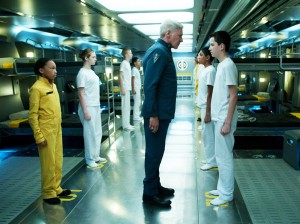The same year that Robert Zemeckis brought us the sci-fi comedy masterpiece that was “Back to the Future,” author Orson Scott Card published a tour de force of his own: the military science fiction novel known as “Ender’s Game.” Despite Card’s fond protection over film rights and artistic control, the Nebula and Hugo award-winning book has now been adapted for the big screen, 28 years later. Released Nov. 1 and with a budget of $110 million, “Ender’s Game” is written and directed by Gavin Hood, the South African director who also created 2009’s “X-Men Origins: Wolverine.” Despite being mostly faithful to the material that inspired it (with some small but major changes), featuring a talented cast and some impressive visuals, it seems that “Ender’s Game” will join “Watchmen” and “Cloud Atlas” on the list of literary works that have been deemed unfilmable.
Though it combines some elements from sequels, the movie’s basic story still follows the first novel’s plotline. In the future, Earth is attacked by an insectoid alien race known as the Formics (referred to as “Buggers” in the first book). After millions of casualties, humanity comes out victorious and forms the International Fleet, beginning to train gifted children who will eventually take command in case of another invasion. Cue Ender Wiggin, a strategically adept genius who is believed to be the very prodigy that the fleet is looking for. The title role is played by Asa Butterfield (the star of Martin Scorsese’s “Hugo”) who imparts a reluctant maturity to the part as greatness is thrust upon him. He is recruited by Col. Hyrum Graff, played by Harrison Ford and comes off as a grizzled and irritable version of Han Solo. Sadly, he isn’t used to his full potential, which is a real shame considering that he anchored some of the most famous and influential science-fiction films of all time (excluding the fourth “Indiana Jones” movie!). Viola Davis of “The Help,” Hailee Steinfeld of “True Grit,” Abigail Breslin of “Zombieland” and Ben Kingsley of “Iron Man 3” all co-star but are squandered as well. While all talented actors, none really pop off the screen in a high-stakes movie that should be engaging and fun.
The movie really finds momentum once Ender is shipped to Battle School, a massive Earth-orbiting space station in which cadets learn fighting tactics and teamwork. Here, we enter a futuristic boot camp full of complex rivalries and dynamics between the recruits and their superiors. Think of it as the opening of “Full Metal Jacket” in space. The emphasis on militarism that pervades both the book and movie is a theme that is reminiscent of works by Robert A. Heinlein, one of the “big three” famed writers of science fiction, along with Arthur C. Clarke and Isaac Asimov. Heinlein’s 1959 novel and its 1997 film adaptation “Starship Troopers” also has a slightly similar plot to Card’s novel.
Some of the most entertaining scenes occur in the battle room, a zero-gravity area where the trainees compete in an extreme version of laser tag. The claustrophobic and futuristic space station sets are like something out of Ridley Scott’s “Alien.” All the while, Hood’s effects team fills the movie with breathtaking and realistic shots of space and lens flares that may remind one of J.J. Abrams’ “Star Trek” reboot franchise. This seems appropriate, as the screenwriters of those movies (Alex Kurtzman and Robert Orci) serve as producers on this feature. Even the short time spent on Earth showcases some beautiful locales such as vast forests and sparkling lakes.
Other captivating sequences involve the “dogfights” between the alien and human ships that are reminiscent of similar exciting aerial battles in “Star Wars” (X-Wings vs. Tie Fighters) and “Independence Day” (Will Smith vs. aliens). However, I would have liked for them to be a bit longer in “Ender’s Game,” which doesn’t feature enough excitement. Instead, the movie tries to focus more attention on the deep, philosophical ideas that Card explored with more success in his book. You just can’t capture such profundity in 114 minutes. Still, the reveals are pretty great (for anyone who hasn’t read the book), and the technology is cool even if it is borrowed from better sci-fi movies like “Minority Report”; the climax even features a Death Star-like weapon of mass destruction.
Perhaps Hood’s ultimate downfall is that he tried to adapt a book that is told from Ender’s point of view — the same reason that Card has stated as justification for calling his book unfilmable. On the other hand, the same narrative technique was also used by Suzanne Collins in her “Hunger Games” trilogy, and Garry Ross did a bang-up job making it work for the silver screen. All in all, the film probably won’t become a sci-fi classic, nor will it add anything new to the genre. Despite taking place in space, it’s not really out of this world.


